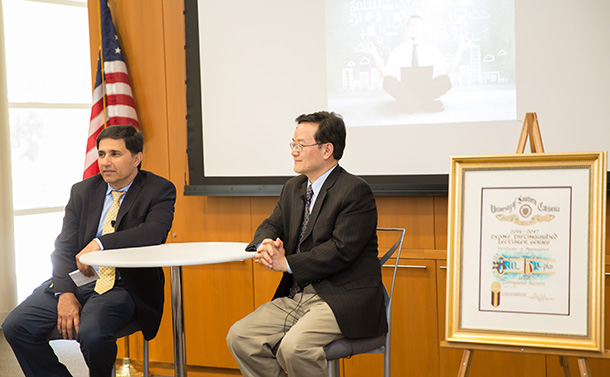A standing-room-only audience filled the Herklotz Seminar Room to hear Bin He, PhD, Distinguished McKnight University Professor of Biomedical Engineering at the University of Minnesota, the most recent speaker in the Keck School of Medicine of USC Dean’s Distinguished Lecturer Series. His presentation, “Dynamic Mapping and Interfacing with the Brain: From EEG to BCI,” took place April 10 at the Zilkha Neurogenetic Institute on the Health Sciences Campus.
He’s lecture explained the methods his team has used to improve noninvasive imaging of electrical activity in the brain with electroencephalogram (EEG) and functional MRI and how these imaging tests relate to the team’s work with brain-computer interface (BCI). Their BCI research has demonstrated that people can noninvasively control a flying robot or a robotic arm, which advances the possibilities for noninvasive brain-controlled neuroprosthetics.
“The narrow definition of BCI,” He explained, “is really to record or detect the mental state, or what the intention is of the subject’s brain, and then use that in a controlled environment to control a computerized device, machine or robot.”
He went on to demonstrate the results of their BCI experiments, showing video of a subject making a small drone fly using noninvasive EEG cap. Applications for this technology include controlling a computer for communication, or controlling a robotic arm, wheelchair and other computerized devices.
Rohit Varma, MD, MPH, dean of the Keck School and director of the USC Gayle and Edward Roski Eye Institute, introduced He at the event, noting that the research by He and his team has applications in many different medical specialties.
“His team has studied not just the brain, but also the heart, and has developed new ways of imaging the electrical activity of the heart. This has helped people with various afflictions, including arrhythmias,” Varma said. “One of his truly extraordinary innovations has been the brain computer interface research, which has really enhanced our ability to understand how the brain functions. The use of this interface in having thoughts control the movement of a robotic arm is truly revolutionary.”
— Amanda Busick


